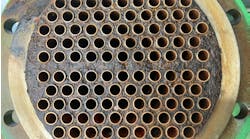While pumping ammonia to our unit in eastern Indiana, the centrifugal pump loses prime for no apparent reason. It then takes several attempts to get the pump primed again. The problem seems to occur more often in the summer, but has occurred in every month of the year. The ammonia is stored in 10,000-gal., insulated saddle tanks with a positive head of at least 10 ft. when the tanks are nearly empty. The typical flow rate is between 5 and 10 gpm. The pump has a minimum flow requirement of 5 gpm, so there is a minimum flow line with a control valve to maintain the flow. What could be causing this problem?
-- From March's Chemical Processing
Determine the NPSH
It sounds as if you don't have enough net positive suction head (NPSH), which is the total suction head in feet of liquid absolute at the suction nozzle and referenced to the datum, less the vapor pressure of the liquid in feet. Your pump specification sheet should chart the NPSH. Check this number with the density and vapor pressure of ammonia at the service conditions, and then calculate the pressure drop across the suction pipe and fittings. Any pumping system must have the available NPSH of the system be equal to or exceed the NPSH required by the pump. A control valve or flow meter installed in the suction line will add to the suction pressure drop. Relocate them to the discharge if this is the case. If not, consider cooling the pump suction line and/or tank, with a traced line of cooling tower water. (I once had to use ice in a pilot plant installation to keep the vapor pressure reduced enough.) The sun might be shining on the tank, which will heat the ammonia and increase the vapor pressure, thereby decreasing the NPSH.
Robert L. Heider, engineer
PEC, St. Louis
Cool pump with water
The problem is caused by ammonia vaporizing in the pump case. Run water over the pump case to cool it, which should condense the vapors and allow pumping.
Margaret A. Vaughan
ExxonMobil Chemical Co., Beaumont, Texas
Locate minimum flow line correctly
A little-appreciated fact is that pump inefficiencies are applied to the fluid and cause a slight rise in temperature, which normally goes unnoticed. Fluid heating is more likely to happen at low pump rates when the pump is running in a poor efficiency area of the pump curve. However, when pumping fluids at or near the boiling point, small temperature changes on the suction side greatly affect the available head. Therefore, the placement of the minimum flow line and any control valve is critical to maintain prime.
For example, if the point of discharge for the flow control valve is in the input line for the pump, then the fluid (at a slightly higher temperature than the material in the tank) again passes through the pump and gains some more thermal energy. This recycling and temperature increase continues until all available head is lost due to ammonia bubble formation and pump cavitation. Ergo, the prime is lost. It will be very difficult to reestablish the prime since the fluid in the pump will need to cool back to a temperature similar to that of the fluid in the tank. To avoid this, the discharge of the control valve must not be piped directly to the suction line. Instead, it should be piped to the tank.
John Corn, instructor, Department of Chemical Engineering
Ohio State University, Columbus, Ohio
Replace centrifugal pump
Van Diest Supply Co., McCook, Neb.
Increase pressure on the tank
U.S. Army Medical Material Development Activity, Ft. Detrick, Md.
Size piping correctly
Tarr LLC, Portland, Ore.
Check instrument lines
CYANCO, Winnemucca, Nev.
De-gas the ammonia
EPCOT International, Pepper Pike, Ohio
Turbulence creates gas pockets
One of the main opportunities for ammonia to flash occurs if the product flow is very turbulent as it enters the pump, creating a large number of gas pockets/bubbles in the liquid. This problem is amplified in the summer by the higher ambient temperatures.
There are two ways to alleviate this problem. The first is to increase your straight piping run into the pump. This will help stabilize the liquid flow and decrease the amount of turbulence. Your pump supplier can help you determine the straight run length in equivalent pipe diameters you need to the pump suction. The second is to oversize the suction line of the pump (i.e., a 2-in. suction line and a 1-in. discharge line). I would employ both of these methods to solve the problem.
Robert Inouye, lead operator
Tessenderlo Kerley Inc., Burley, Idaho
Summer temperatures heat the ammonia
My first guess would be that the ammonia is heated during the summer in the tank, lines and pump. This heat is enough to cause the fluid to flash at the eye of the impeller. This then vapor locks the fluid and breaks prime. You can increase the head on the suction side, insulate the pipe and pump casing, get a pump with lower NPSH requirements or physically lower the pump so you increase the suction head.
Carl Jones, director of sales
Bott Equipment, Houston

